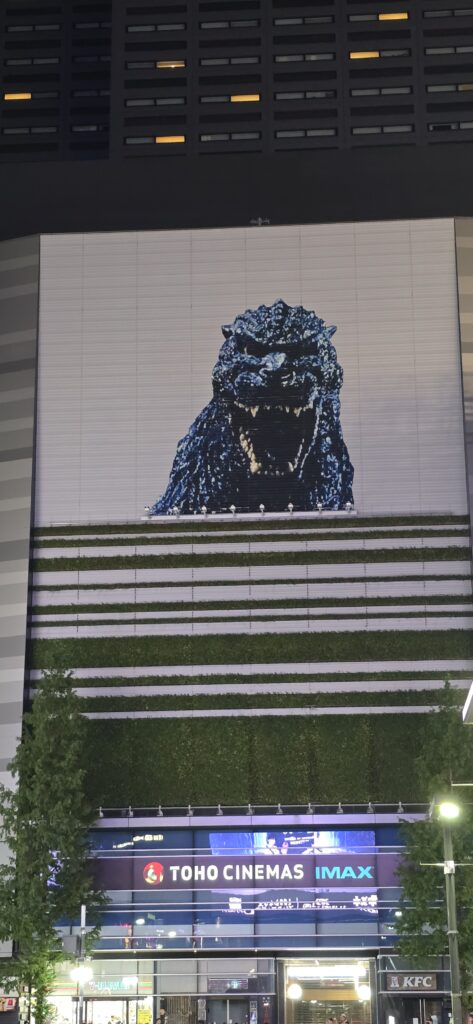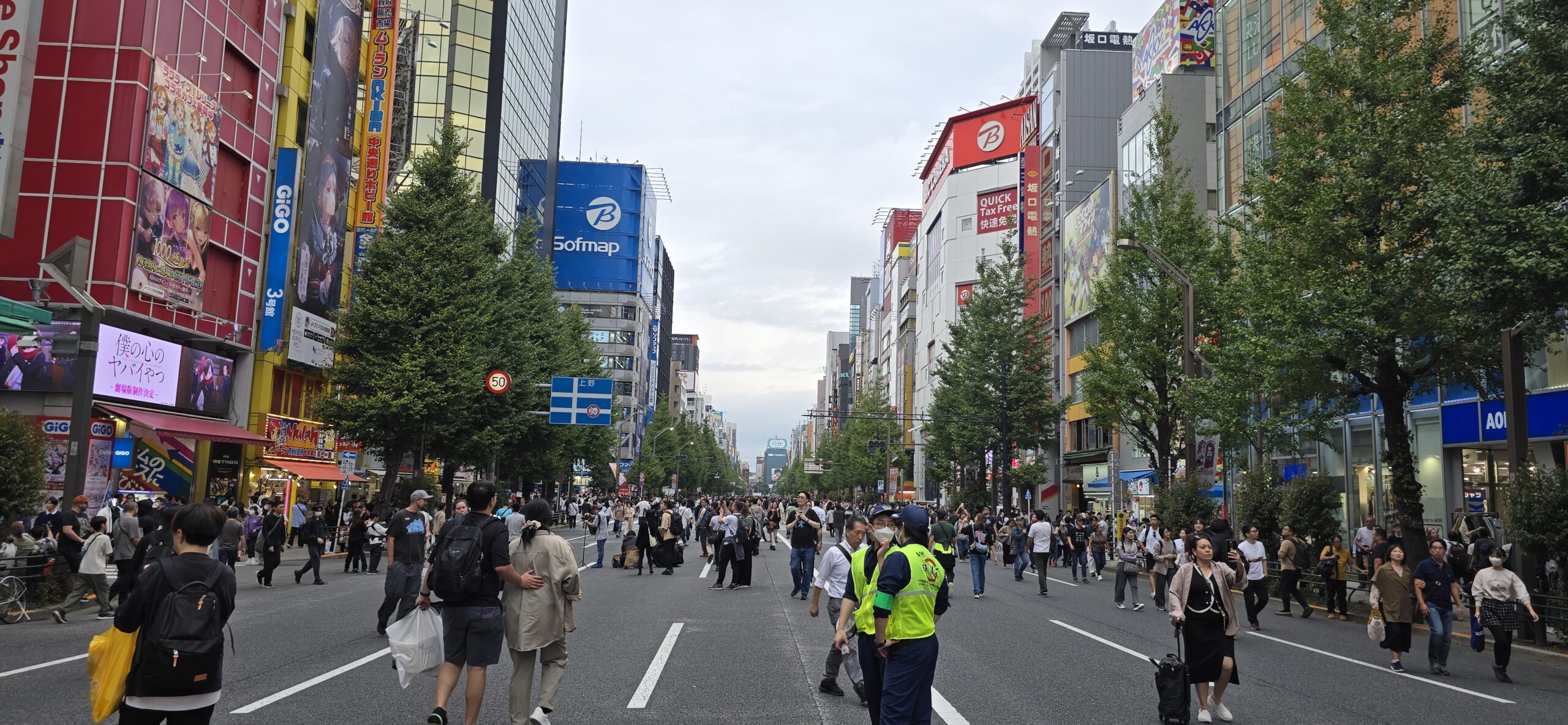Overview:
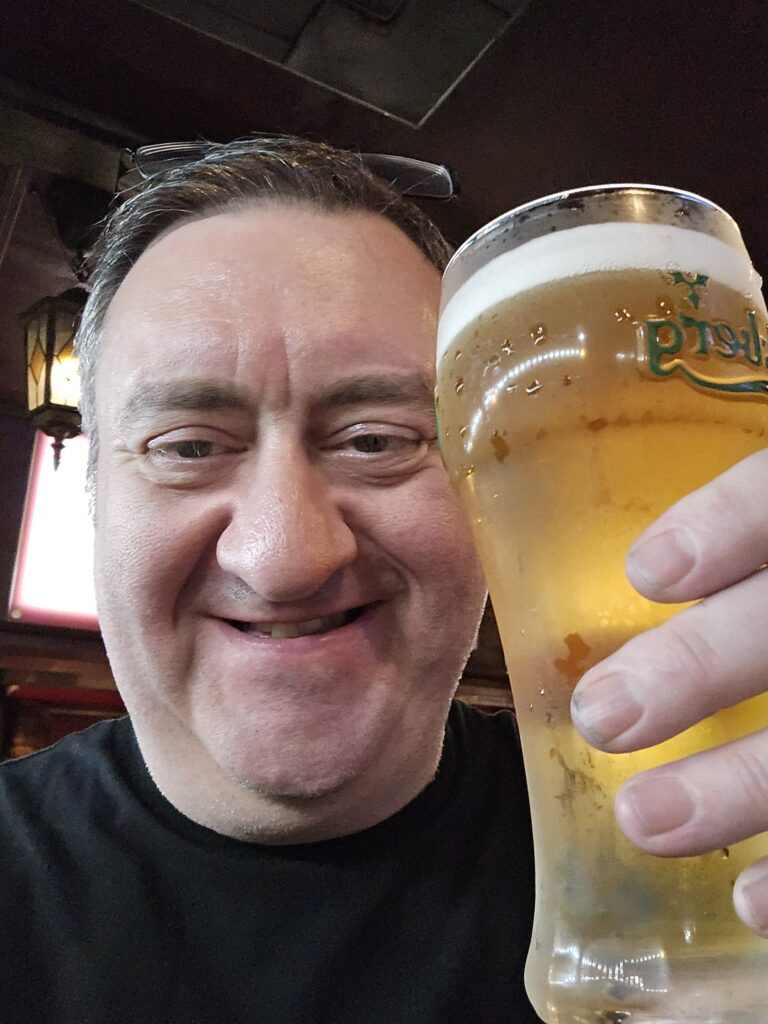
My name is Lee. I live in the UK and have been to Tokyo three times. I have learned a lot through experience and have laid out everything I wish I knew, before I went the first time, in this blog.
Tokyo is as about as big as Wales and there are numerous ‘towns’ that all have their own ‘vibe’.
The vast majority of my time has been in Shinjuku (the bar, club and food area) and Akihabara, AKA Electric Town (where the arcades, anime and manga are).
The best advice I can give is that Tokyo has everything you can imagine and you can do anything. Decide what you want to do before you go, then research the towns in Tokyo that have it.
Flights:
There are 2 airports that service Tokyo: Haneda and Narita.
Haneda is easy and quick to get to Tokyo from. Get off the plane, go through customs etc. and then get the monorail to Hamamatsucho. A bit later I talk about the Suica Welcome card, which you can buy at the machines next to the monorail gates. Buy one and head to the monorail.
Skip to the research section video and watch the Haneda to Shinjuku by train video on YouTube. It goes through everything step by step. It is an essential watch.
Then change to the Yamanote train line. The Yamanote line is a circular line that visits all the main towns in Tokyo. It will take about 45 minutes to get to Shinjuku.
If you imagine the Yamanote line as a circle, there is another line called the Chuo-Sobu line that cuts straight across the middle which can be useful, especially when going from Shinjuku to Akihabara.
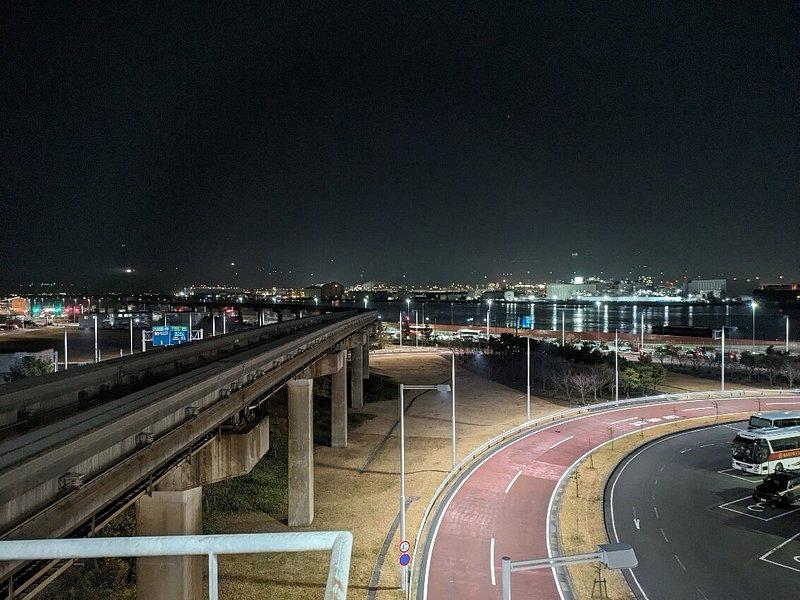
A special mention for the monorail ride because it is fantastic. It skirts the edge of Tokyo, being built over the water. The city views idling past make it feel like you are taking a ride into a video game. Going in and out of Tokyo on the monorail is one of my favourite parts of the trip.
From Narita, get the Narita express, it takes 1.5 hours to get to Shinjuku.
There are a number of different flight routes from the UK to Tokyo and I have used two of them. At the time of writing the only direct flights to Tokyo are from London Heathrow.
The first route I took was indirect from Heathrow to Narita with a lay-over in Hong Kong, the second route was direct to Haneda.
It is usually cheaper to do the lay-over. But a four hour lay-over on top of a 14 hour flight is not fun. My advice is get the direct flight.
I always fly premium economy because of my fat arse. I have flown with 3 companies on two different routes. I wouldn’t worry about which company you fly with, but definitely, if you can, get a direct flight from Heathrow to Haneda.
SUICA Card (pronounced sweeka)
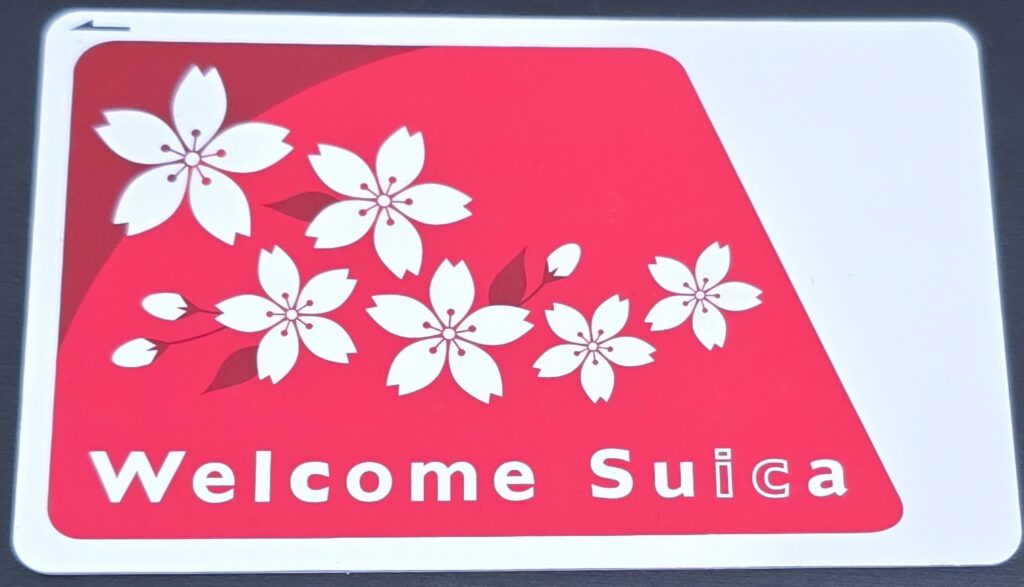
Japan is mostly cash based, so you are told, and it is true, but what you might not be told is that everywhere accepts a card called the SUICA Welcome card. It is basically a pre-pay cash card and absolutely essential for travelling on the train. It is specifically designed for tourists, being an offshoot of the regular Japanese Suica card.
As soon as you get off the plane, first chance you get at the very first machines, buy a Suica Welcome card.
You can get one from a ticket machine near the platform gates. There will be many machines in a line selling various types of ticket, but probably only one that says Suica Welcome, that’s the one you need to use.
The machine has an English language option, select it and the rest is easy. Select how much you want to load the card with, put the money in, get the card.
Seriously, do not try to travel without one. Just don’t.
You will be fine putting 2000 yen on a card at first and you need one card per person,
A general note about all machines in Japan that take cash, whether it’s for a Suica Welcome card, in a conbini or a vending machine or anything else: They all work and they all give change. It’s not like in England where the machines are a pain in the arse. They always work, all the time, so don’t fret about using them.
Any money you put onto the Suica Welcome card will expire after 30 days. Keep a couple of thousand yen on it, add extra as you run out of money on it then near then end of your visit, at the airport, use whatever is left to buy snacks from the vending machines with your remaining balance.
When you put your Suica Welcome card on a card reader at a train gate, the gate has a display that tells you the amount left on the card so you don’t need to worry about running out of money on the card unexpectedly.
When you do eventually need to put more money on your card, go to any station, find the Suica Welcome machine, put your card in the machine, put some money into the machine and that’s it.
The Trains:
The trains in Japan are very frequent, very punctual and very confusing.
All the lines and routes have English announcements and English text. All the trains have clear displays (which cycle between Japanese and English) in every carriage. There is an English voice telling you where you are and what the next station is.
Every station has a decimal reference number and every sign and announcement states the decimal number. So you can navigate using station numbers rather than names if you like.
The information and announcements are better, by far, than in England so don’t be afraid to use the trains.
They are also cheap for local trips. 2000 yen will get you a good number of trips.
Why do I say it’s confusing? Because you are not prepared for the size of their train stations. Shinjuku train station is a monster, the busiest on Earth, and the number of people going through it is incomprehensible. The best image I can muster is leaving a football ground or concert, all the time, everywhere.
That means there are many, many lines and platforms, and you will get lost.
The trick is to know which line you want and which company owns that line. Then when you enter the station, follow the signs to the company, then look for the line you want, then pick the platform with the station on it that you want to go to. There are plenty of signs to follow but I guarantee you will still get lost. Don’t sweat it though, it’s all part of the fun!
The Yamanote line is run by the JR East company. So when you enter a station, look for the JR lines, then the Yamanote line, then the station you want (so you go in the correct direction!)
Train Etiquette:
- Don’t talk loudly, and preferably don’t talk at all.
- Don’t look at anyone in the eyes.
- If you have a big bag, wear it on your front so it isn’t blocking people behind you.
- There are lines on the platform floor that show you where to queue. Queue in them. Make sure you queue, it is not like Britain where it is basically a free-for-all.
Shinkansen, AKA Bullet Train:
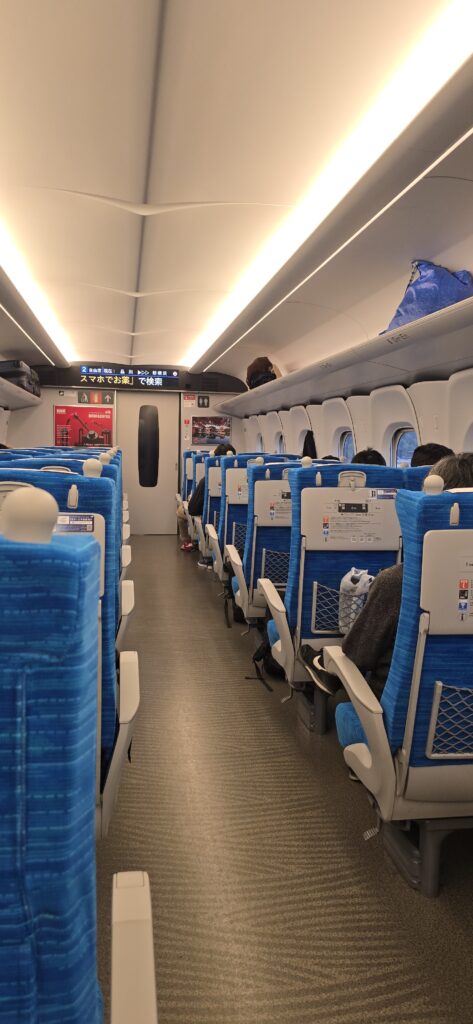
The Shinkansen is used to go across Japan and has its own stations. You need to jump onto the Yamanote line, go to a Shinkansen station, queue up at the special Shinkansen ticket desk and buy a ticket there. The staff speak reasonable English so you should be fine. You can’t use a Suica Welcome card to buy a Shinkansen ticket as far as I know. You might have read that you need two tickets but don’t worry about that, if you go to the desk they give you everything you need.
Update: 17/11/24: I have read that the Shinkansen can now be booked using an app which gives you a QR code that can be scanned at the gate, rather than using the desk. I have never used it but it will be worth checking out.
I went on a Shinkansen to watch a band called Band Maid and they put our trains to shame. 200mph. OMG.
When you book a train you can either reserve a seat, or not. The temptation is to reserve a seat but my advice, from personal experience, is not to do that. Here’s why.
Because my last name is Ramsbottom, the most efficient and punctual train service on Earth stopped running on the day I needed to catch it. Heavy rain meant all the Shinkansen trains that morning had been delayed, so every single train was late (in the afternoon). Now here’s where things got interesting.
I (and my mate) bought unreserved tickets, and because of that we could get on the next train, go to the unreserved carriages (always carriages 1, 2 and 3) and get in any seat. Job’s a good ‘un.
But those who had reserved couldn’t do that. They had to wait for their train coming, even though it was 3 hours late and not due for another 2 hours. It wasn’t like in England where if your train is late you just jump on the next one because all bets are off. No, they had to wait for their late train. Or at least I think that’s what happened.
I’d rather have the option of jumping on the next train.
Update 11/12/24: I have read that, from June 2025, the number of carriages allocated to unreserved is changing from 3 to 2, so there will be fewer unreserved seats available, which might make my advice null and void.
Maps:
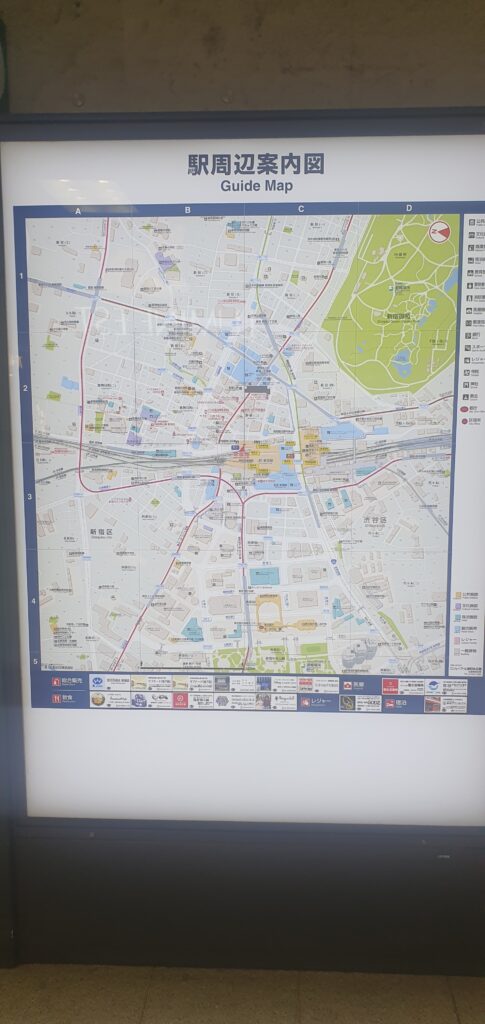
Maps are not orientated with north at the top like in the UK. This caused my mate and I to spend about an hour trying to find an exit and nearly throttling each other after 24 hours of travelling when we couldn’t find it. It was excruciatingly frustrating. And then I realised south was up!
Just look at the way north is indicated at the top right of the picture above!
The maps are orientated the way you are facing. So if the map shows where you want to be as located in the top left corner, that means walk straight ahead and to the left. It does not mean walk northwest!! Apparently the powers that be are trying to make this the normal way to do tourist maps in the UK.
That said, Google maps is fantastic now and will get you anywhere. Speaking of which:
Wi-Fi:
Wi-Fi is a pain in the arse to get. The train stations have it and the bigger shops but it is not ubiquitous. That is because most Japanese people have a phone with 4G or 5G.
By far the best thing to do is buy a Japanese E-SIM if your phone will allow it. I paid £20 for 50GB for 30 days from Mobal Japanese E-Sims. I could then use the internet for location services all the time and use Google to get everywhere.
I highly advise you get a Japanese E-SIM. If you use Mobal, make sure you follow all the instructions including the bit about access points. It won’t work automatically when you land, but worked perfectly after I followed the instructions. This is not sponsored, it is just what I used.
Mobal – Short-Term 30 day E-SIM
Japan eSIMs: Get a Japanese Phone Number or Data-Only Plan from Mobal
Translation and Communication:
The vast majority of younger bar tenders, waiting staff and shopkeepers speak a little English. American English.
Don’t start wittering on in your local dialect, have some respect and speak slowly and clearly in primary school English. Use American words that are well spoken, and most bars, coffee shops, cafes etc. will understand what you say.
They will always understand numbers up to ten and things like beer, whisky and vodka. E.g. everyone will understand, ‘two beers please’.
That said, everything else is incomprehensible. You will not recognise anything except pictures of food (and not half of that) and the toilet signs.
The absolute best thing I found was Google Lens. It is superb. It translates all the pictures and words immediately and inserts the translation into the picture. I highly advise using this if you can.
I have a Samsung Galaxy phone so could use their voice interpreter app which translates speech. Use whatever your phone has available on it and it will serve you well.
As it happens, a lot of the shopkeepers use tablet computers specifically to translate to English.
Hotels:
I have stayed in two hotels, both in Shinjuku. The Listel Hotel Shinjuku and the APA Kabukicho Tower, both booked through booking.com and had no problems with either of them.
The Listel is a budget hotel but perfectly fine, I have stayed there twice as it is (very) slightly just outside Golden Gai. A bargain for the money.
The APA is part of a chain and there are loads of them. It is still a budget hotel, like Premier Inn, more expensive than Listel but much better located for Shinjuku.
Both hotels had air-con.
Do not underestimate how small the rooms are. I always have a twin room with my mate and basically there is room for two beds with a 30cm gap between them, a bathroom and then a door out. You will just about find space for two open suitcases and neither hotel had a wardrobe. They’re tiny compared to the UK. No doubt you can get bigger rooms but no doubt the cost ramps up.
There were plenty of power points in each hotel (Japanese two pin) but I took a four plug UK power strip and plugged it into a single Japanese socket using a travel adaptor and then charged my phone etc. from there.
The APA had a small fridge and both hotels have shampoo, soap, spare toothbrushes, toothpaste, razors etc.
The bathrooms are small but functional. They both had a sit in bath and lovely powerful showers. The toilets had the obligatory riggot power cleaner built in (aka a bidet).
Neither hotel had a safe in in the room. For valuables you have to leave them in a secure envelope behind reception. But remember you are in Tokyo, the chance of anything being stolen is miniscule.
The reception staff treat you like royalty and will help you as best as they can. The receptions offer laundry services too, which I used in both hotels and had no problems with. (Except how embarrassingly fat my jeans are compared to everyone else in Japan!)
Listel Shinjuku Hotel: https://www.listel.co.jp/
APA Kabukicho Tower: APA Hotel Shinjuku Kabukicho Tower | [Official] APA Hotels & Resorts | Business Hotel Reservation Site
Size:
Everything in Japan is small (except the massive buildings and trains) but most importantly the gaps between things. Gaps between tables in coffee shops, gaps between fixed chairs and tables, gaps between beds, gaps between aisles in shops, and gaps between people are tiny compared to the UK.
They have to be that way because there are so many people, just live with it and sit yourself in one of the tiny little spaces and don’t worry about it.
The vast majority of people in Japan are thin. If you are fat like me, expect random strangers to pat your belly and say ‘too much Ramen hehehe’. It’s funny and they mean it in good humour, so don’t be an arsehole and take offence.
Members Only:
Japanese establishments are allowed to discriminate against foreigners. If a shop or bar says ‘members only’ or ‘locals only’ on it, that means Japanese people only.
Also, if a bar or restaurant only has Japanese writing on its door or signs, it’s a good indication you aren’t welcome.
Don’t worry about it, the vast majority are welcoming to foreigners and you can tell which they are because they have English on the doors and signs, often saying, ‘Foreigners Welcome’ or have English menus.
Gaijin Tax:
Gaijin means ‘foreigner’ and some restaurants will charge you more because you are foreign. Don’t argue about it, just pay it and have fun. If it bothers you then don’t go back.
Police:
I have not had a single problem in any part of Japan I have been to. But, and you must understand this, if you are arrested by the police, or even accused of a crime, they have a 99% prosecution success rate. If for some reason you get in trouble with the police and they issue you with a fine or something, even though you didn’t do it, just pay the fine. You will not get any justice and even trying to will land you in prison for 23 days for no reason other than they accused you of something.
In Japan you get your chance up-front and you get a lot of leeway. Be polite, don’t mess about arguing with people or being noisy and loud, in pubs and bars. It is not like Britain. If you get arrested, take the quickest and easiest way out. Pay the fine or whatever.
Tokyo is a quiet place and designed for people to keep to themselves. Don’t stand out.
Your Passport:
It is a legal requirement in Japan for foreign visitors to have their passports on them at all times. So make sure you have your passport on you at all times!
Failure to show it to the police on request carries a 100,000 yen fine.
Politeness and service:
Everyone, everywhere is polite, all the time. Shops and bars practically worship their customers when they walk in. So be polite back. They bow, a lot, so do the same. It’s fun.
When giving a shop assistant money you do not give it to them by hand. You put the money onto a tray on the counter, and they will give it you back on the tray on the counter. Usually, when giving change, they count the notes first, then the coins.
To be ultra polite, do not point at things with a single finger like we do in the UK, use an open palm and point with your whole hand. When selecting from menus etc. put the back of your hand on the counter and indicate with two or three fingers what you want, so you have an open palm.
Sumimasen! (sue-me-ma-sen)
It means excuse me, and sorry. If you bump into someone – sumimasen! If you need to get past someone – sumimasen!
But most importantly many wait staff will not serve you automatically like in the UK. You have to catch their eye and give a hearty (not too hearty!) sumimasen! and they will come and serve you. If you don’t you will be sat there for a very long time, parched and starving.
Safety:
Tokyo is the safest city in the world. You can practically leave anything, anywhere and no-one will take it. You can leave computers, bags, cameras and even cash and it will not be taken. So if you forget something in a shop, bar or club, just head back there and it will where you left it, or behind the bar/counter.
I am the type of person that is out ’til very late, often rolling into the hotel at 7am after a night in various metal bars and offal soup restaurants. I have walked back to the hotel, through the dodgiest red-light district in the entirety of Japan at 5am many times and felt safer than in my home-town.
All that said, the usual rules for a city apply. Try not to leave things out and keep your belongings close to you. Crime can happen, it’s just less frequent in Tokyo.
Tipping:
You will read, and be told, that there is no tipping in Japan. That is both true and not true.
In the USA they tip every time and it is basically a service charge. This type of tipping does not happen in Japan.
In the UK we tip if we want to, either adding 10% to the bill or giving the bar staff a pound or whatever. This also does not happen in Japan.
Doing either of the above will basically insult the server and they will chase you down the street and give you the money back. Just don’t do it, not even in the British themed HUB pubs.
However –
Many places have a cover charge (many don’t). It is always displayed on the door or marked clearly on the menu. You will be expected to pay the cover charge for each person in your group and then a minimum of one drink each.
That is the tip. Treat the cover charge as the tip. It is ridiculous how many UK people do not go into places because of the cover charge, ‘pfft, I’m not paying to sit down!’. Remember you are in a foreign country and it is the tip.
It is also etiquette, especially in places that have no cover charge, to buy the bar staff a drink. And that means literally buy them a drink, whatever it costs. Offer them a beer or whatever you are drinking, they will pour it out and drink it with you. I don’t mean the whole bar staff, just the person serving you. And not every ’round’ just one or two drinks depending on how long you are staying.
Unless it’s Bar Buster in Golden Gai and Mami-San or Hiro (her husband) are serving. They are the best, especially Mami-San (sorry Hiro!), buy her one every round. And if Kaori pops in, buy hers too!
Eating:
Everywhere will expect you to be able to use chopsticks, which are called Hashi in Japan (in the UK we don’t pronounce H in many of our words, in Japanese be sure to pronounce it).
A lot of restaurants keep them in a little drawer on top of the table to the side. If you see any little drawer handles, chances are the chopsticks are in there.
You can always request a fork and some, not all, will bring you a fork anyway (stupid foreigner!).
Take some time to learn to use chopsticks, it’s really good fun. There are loads of tutorials on YouTube. One thing to remember is that rice in Japan is ‘sticky’, clumping together so it can be picked up with chopsticks or shaped into balls. In the UK we tend to use long grained rice that does not stick together. When practicing in the UK, don’t worry about the rice! Pick up the meat and veg etc. Once you have practiced for a few minutes you’ll be fine.
When eating noodles and soup you will normally be given a wooden spoon, which is used to eat (drink?) the soup. A top tip for avoiding soup-splash is to pile the noodles onto the spoon, using your chopsticks, then eat from the spoon.
The Japanese will also pick up the bowl and use chopsticks to shovel food into their mouths from a few inches away. You don’t have to pick noodles up the whole height from the table to your mouth, watching them slip away. Pick the bowl up!
The Japanese also slurp the remaining soup from the bowl! It is so freeing from UK table manners! Use two hands when holding the bowl though!
Look Up!:
In the UK we are used to retail shops and bars sprawling out on the ground and first floors of buildings. Our perspective tends to be flat.
In Tokyo, and I assume the rest of Japan, you need to look up. You will have seen pictures of the buildings in Tokyo with all their neon signs. Have another look now and notice that what you are looking at is a large sign the full height of the building with a picture or business logo against each floor. That’s because the shops go up!
Often when you walk into a building you are met with a bleak hallway and a small lift at the end, so to our UK eyes it feels like walking into danger. But it isn’t. Get into the lift and go to the floor where the business is that you want to visit!
Don’t forget to look up!
Conbinis (kon-bee-nee):
A lot of words in Japanese are taken from English, and then shortened. Also they replace V with B. So ‘convenience store’, becomes ‘convini’, becomes ‘conbini’. There are conbinis seemingly everywhere, with 7-Eleven and Lawson being the two most popular.
Get yourself an egg salad sandwich (from any conbini) and taste the greatest egg sandwich ever. It will become your go-to food after an evening on the beer no matter how much you have eaten. The conbinis are a veritable wonderland of glorious taste experiences. Try everything.
Smoking:
Most establishments are non-smoking but have a smoking room you can go to. If you need to move from your seat just leave something there and no-one will steal your seat or the thing you leave. They just won’t.
In Golden Gai it is forbidden to smoke outside, you must smoke inside an establishment and most of them allow you to smoke without restriction.
Toilets:
Most toilets have an obvious picture of a man or woman and they are mainly unisex in the smaller places. You won’t have any trouble finding toilets.
The majority of toilets are western style but with a bidet built in. Have fun working out the controls and get a proper power-wash up that riggot. Some of them play a jolly tune or bird-tweeting nature sounds to mask your toilet noises.
I found that the majority of toilets were less hygienic than in the UK so it might be worth buying a small bottle of handwash from a conbini and carrying it with you.
There are very few hand-dryers or hand drying tissues (they do have toilet roll so don’t worry about that). Traditionally, the Japanese carry a small hand-cloth and dry their hands on that. My advice is to take a small 10cm square hand towel, or buy one from a conbini, or get used to drying your hands on your jeans.
Knock knock knocking on the toilet door!:
I don’t know if this happens in the women’s toilets, but in the men’s or unisex toilets if you take too long, the people waiting will knock on the door to hurry you up. Don’t sit there scrolling, sit and dump – or snip it off at both ends – and get out!
No Bins (trash-cans):
I guarantee that Tokyo is the cleanest city you will ever go to.
Ironically, when you are walking about outside, there are no bins. If you buy a bottle of water you will be carrying that bottle forever. The Japanese are used to taking a little bag and carrying their litter.
That said, I realised that some bigger shops and all the train stations have recycling stations where you can drop off your rubbish, so I started to get used to looking out or them. There just aren’t any on the main streets.
Vending Machines:
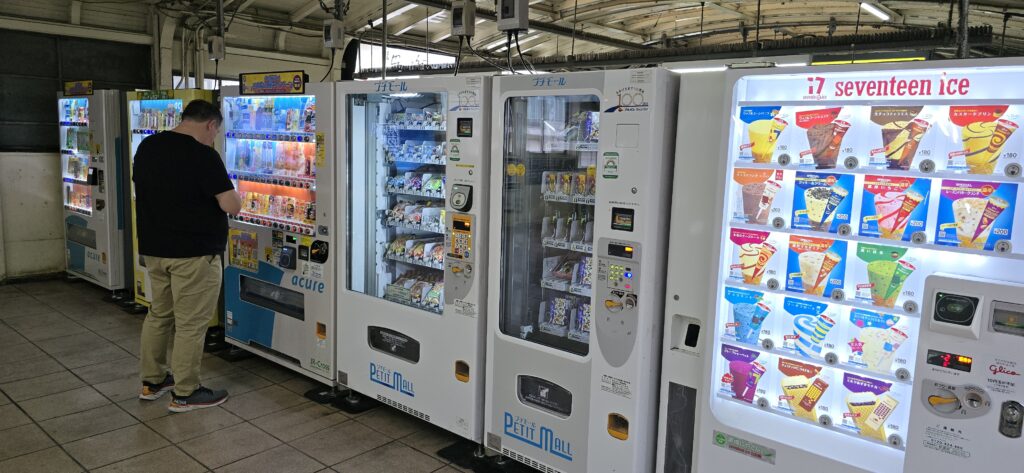
There are thousands of vending machines and they normally contain various soft drinks, water and chilled coffees.
Unlike in the UK, they all work all of the time. They will never rip you off your money and always give change.
Don’t fret about using them, they are awesome.
Crossings:
You can cross the roads anywhere but most people use the crossings. Never, ever cross the road until the green ‘walk’ sign lights up. Even if it is late at night and there is no-one around and no cars on the road. Just don’t do it. Someone, somewhere will see you and glare and tutt at you, the stupid foreigner!
For the love of God be quiet!:
Despite it’s size, Tokyo is very, very quiet. The people there are very reserved and quiet. It is the perfect place for introverts! Don’t get me wrong, people talk and have conversations and there is a bustle, but there are hardly any raised voices or shouting. When you get there just listen and you’ll see what I mean, for a city it is amazingly quiet.
If you are a normal speaking UK man or woman, just talking, you will be too loud. Just the intonation from your voice is too much. My advice is use your inside voice everywhere, even outside. I’m not saying don’t speak, just be aware that even a modestly raised voice will be aggressive and offensive to Japanese people around you.
Keep Left:
In Tokyo keep left on escalators and when you are walking in most places. People will expect to pass you on the right. If you don’t you will get a lot of practice saying and hearing sumimasen!
I have read that in Kyoto everyone keeps right!
Don’t Stop in the Street:
When walking along a street, if you need to stop, move to either edge of the pavement and if there is a group of you do it in single file. There are so many people, it is very rude to stand there blocking everybody!
Don’t Hold Doors Open:
In the UK we tend to hold the door if there is someone close behind us, or in some cases a short jog away, but in Tokyo there are too many people. Just walk through and let the door hit the person behind you. It’s how Japan works.
Shinjuku:
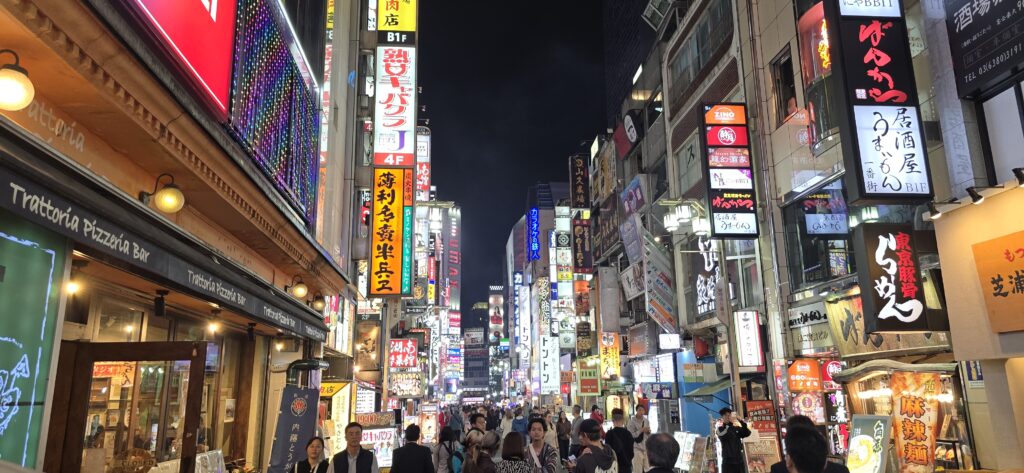
Shinjuku is a night life area and contains a smaller area, the infamous Kabukicho, Tokyo’s red light district, but that’s like saying SOHO in London is a red light district.
Yes it is where all the sex stuff is, but for example, there is the newly built Kabukicho Tower there, an ultra-modern building with free shows outside it and shopping and stuff inside.
Heard of Godzilla? The company that make it is called TOHO and their massive and modern main cinema is slap bang in the middle of Kabukicho, along with all manner of food shops and hotels.
You might have heard of the famous Robot Restaurant. It’s shut down now because of covid but that was in Kabukicho. (It’s been replaced by the Samurai Restaurant.)
COCO curry? Kabukicho.
Really, Shinjuku, Kabukicho, Golden Gai and Omoide Yokocho are bar, club and food areas and where all my favourite bars are. All the sex stuff is there but you will really, really need to look for it.
Beware of touts. DO NOT FOLLOW TOUTS. They will hound you non-stop if you are a single man or a group of men. They will do their best to be happy and jolly and offer all sorts of deals on drinks, ‘titty bars’, ‘massage’ and such like. DO NOT FOLLOW THEM UNDER ANY CIRCUMSTANCES. DO NOT GO INTO THEIR BARS. DO NOT ACCEPT THEIR OFFERS TO JUST LOOK IN THEIR BARS. JUST DO NOT ENGAGE OR TALK WITH THEM IF POSSIBLE. They will hassle you until you walk out of their ‘patch’ at which point they will walk away (and probably a tout in the new patch will come along.) All the (very) bad stuff happens when you follow them, just look it up.
That said, there are plenty of bars with someone (usually a man) stood at the entrance that might invite you in. That is fine. If in doubt do not go in. Read reviews about the bar online, or walk past it the next day to check it out. It’s the touts that follow you that are the problem.
Women (and men) on the street dressed as maids with a sign.
These are not prostitutes. They work in ‘Girls’ bars’ (or Boy’s bars) and are where you go to simply talk and drink with the woman of your choice (or man) for the price on the sign. They only accept people who speak fluent Japanese. I have never been in one of these bars or tried to get in one, but that is what they are stood there for.
The Big 3D Cat on a building:
The big 3D cat-on-a-building is at Shinjuku Cross, in Shunjuku. Great to take the kids (I guess) or get a video for them!
https://maps.app.goo.gl/TnHu656CaQpoYifdA
The Cat Cafe:
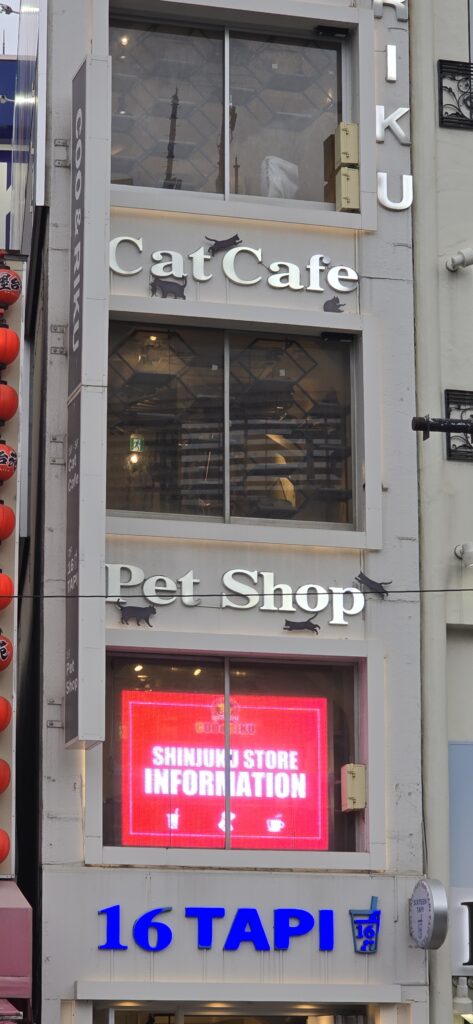
And right across the road is the Cat Café.
If that doesn’t float your boat, there is also a dog café and piglet café. I’ve never been but a quick google search will find them.
Akihabara: Also known as Electric Town:
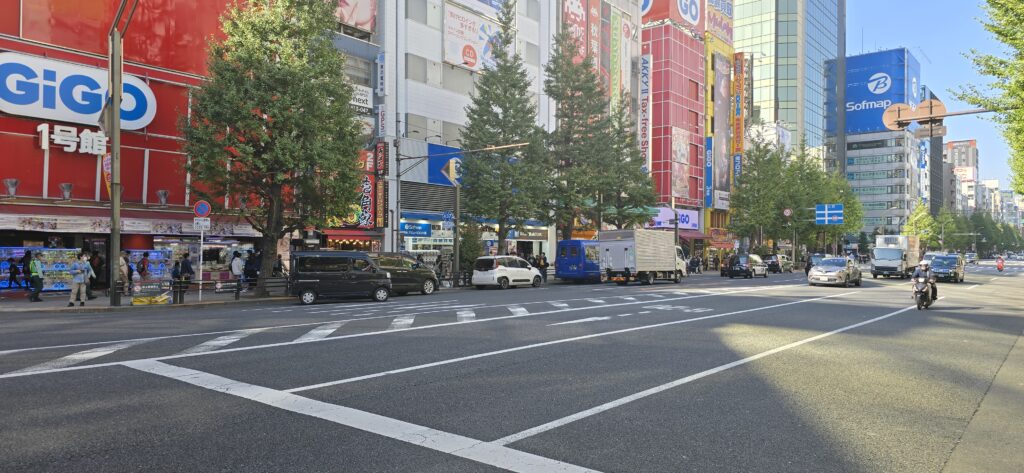
Akihabara is where all the electric stuff is! All the anime, manga, maid café’s, electrical superstores, second-hand games stores, video game arcades, figurine stores and everything you associate with ‘Kawaii’ is here. It is a must visit. Hardly any bars though!
It is on the other side of Tokyo to Shinjuku so about 30 mins on the Chuo-Sobu line.
UFO ‘Claw’ Machines:
Akihabara has of thousands of them. They generally don’t work like UK claw machines (though, to be fair, some do). Put your money in then try to nudge the item off the rails. You aren’t normally trying to pick the item up like you would in the UK. You can ask a member of staff to reset the item if it gets stuck. And somehow, if you spend enough, they will give you the item. I haven’t worked out how to do that yet though.
Women (and men) dressed as maids on the street with signs – Maid Cafés.
They are not prostitutes, the same as in Shinjuku, except some of them are inviting you into a Maid Café, and they will accept foreigners. You can generally tell because you can see or hear the Maid Café. Again, surprisingly this time, I have never been in a Maid Café but there are loads of videos on YouTube. It is a café but the staff act like they are in an anime cartoon or something and serve pretty food and drink at stupid prices, they also do a song and dance.
Shibuya:
You might have heard of ‘Scramble Crossing’, that is in Shibuya, right outside the station. I haven’t spent much time here but it seems to be where all the shopping is. It is where you will find the massive Tower Records (but remember this is a Japanese record shop) and the Nintendo store.
Research:
Almost everything I have talked about can be found on the internet somewhere. There are some awesome resources about Japan and I think it would be worth having a look at the following (none of them are adverts or sponsored, just my genuine advice).
If you like the walkthroughs etc., please leave a like on YouTube for the content creators and consider subscribing to them. There are tons more videos on their sites. Again, this is not sponsored, just my genuine advice.
A walk through of Haneda to Shinjuku: How To Get To Tokyo on YouTube have a brilliant video showing every step of getting from Haneda to Shinjuku, including using the ticket machines for the monorail and Suica. This is an essential watch.
Chris Broad – A Broad In Japan: Chris travels to every station on the Yamanote line and explains the vibe of each town. A must watch.
A walk through Shinjuku Kabukicho:
A walk through Golden Gai:
A walk through Omoide Yokocho – Memory Alley:
The JR East train line site: When you go online in the UK to book tickets for trains in Japan, most of them are agencies that charge a fee. Here is the official JR East train site. Don’t bother with them, just use SUICA Welcome.
JR-EAST – East Japan Railway Company
My Favourite Drinks
Plum Wine and Soda Water – umeshe soda
Hub real ale (only at the HUB pubs)
Kirin
17 year whisky
Miso Soup (not sure that counts as a drink!)
My Favourite Places:
Golden Gai:
My absolute favourite drinking place. There are 6 alleys with hundreds of tiny bars that seat a handful of people at once.
They are small but each bar has its own toilet so you don’t generally need to worry about that. Don’t be afraid to squash past people when you go to the bog! ‘Breathe In!’ is what I shout. It’s all in good fun and humour.
Don’t just walk past the bars, go in. There are many, many themed bars of all types so if you see one you like, go in! Don’t be afraid! I have met the funniest and most interesting people in bars in Golden Gai. Everyone has been friendly and all of the bars I have been in have staff that speak at least a little English.
Remember that there are bars on top of the ground floor bars, you’ll see the very steep stairs. Go up them, open the door and see if there is room.
Everyone is friendly – except the bars that say ‘members only’.
Make sure you visit Bar Buster – Golden Gai! (Timestamp 9:43 in the Golden Gai walk-through video above)
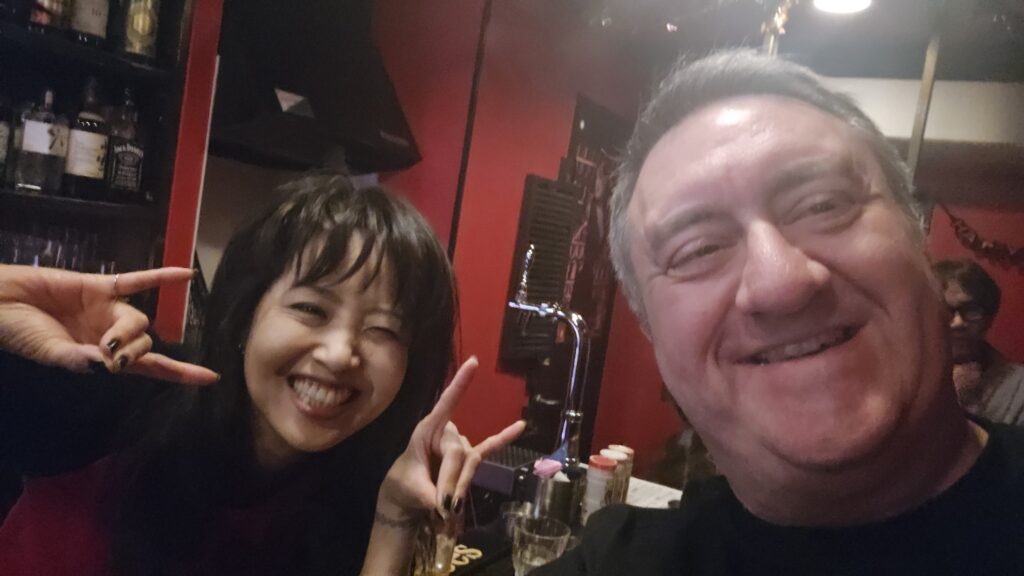
(Only the Fox God knows!)
The HUB pub chain:
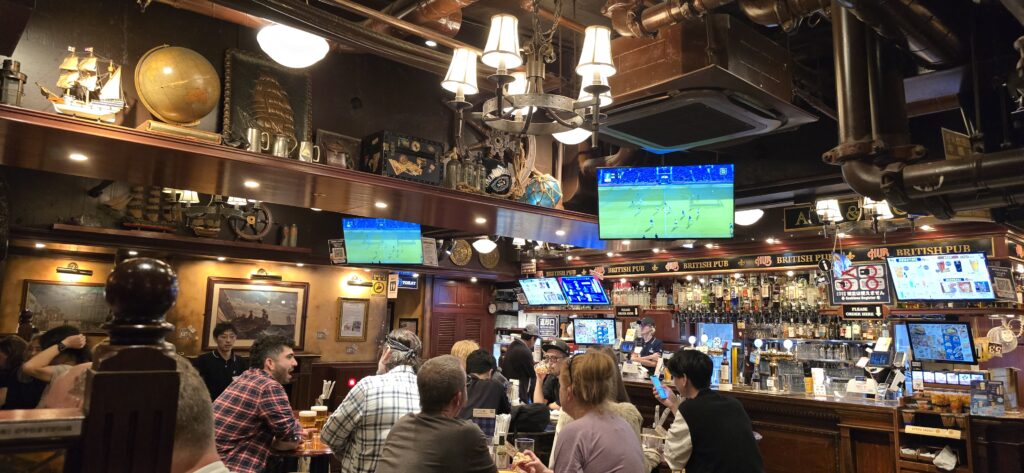
I know it might seem a bit redundant for a British person to go to a British pub in Tokyo, but hear me out.
The HUB pubs are very close to what a British pub is like, and so people tend to be a lot more animated, including the Japanese people in there, which leads to some awesome nights, especially when baseball or football (soccer) is on the TV. It’s the kind of vibe you don’t get in most other pubs.
They also have a decent pint of Kirin lager or Hub Ale, and it is a pint, again unlike most other pubs which are 2/3 pints at best.
There are four HUB pubs in Shinjuku and I use them as a starting point for the night, where I would meet my friends.
When you walk into a HUB pub you will be greeted by a server who will show you either to a table or somewhere to stand. Unlike in the UK, this is a queueing system. If a table becomes free you will be offered it if you are in standing.
Note: you are not allowed to move the chairs and stools about like in the UK.
They have amazing fish and chips, better than most UK fish and chips.
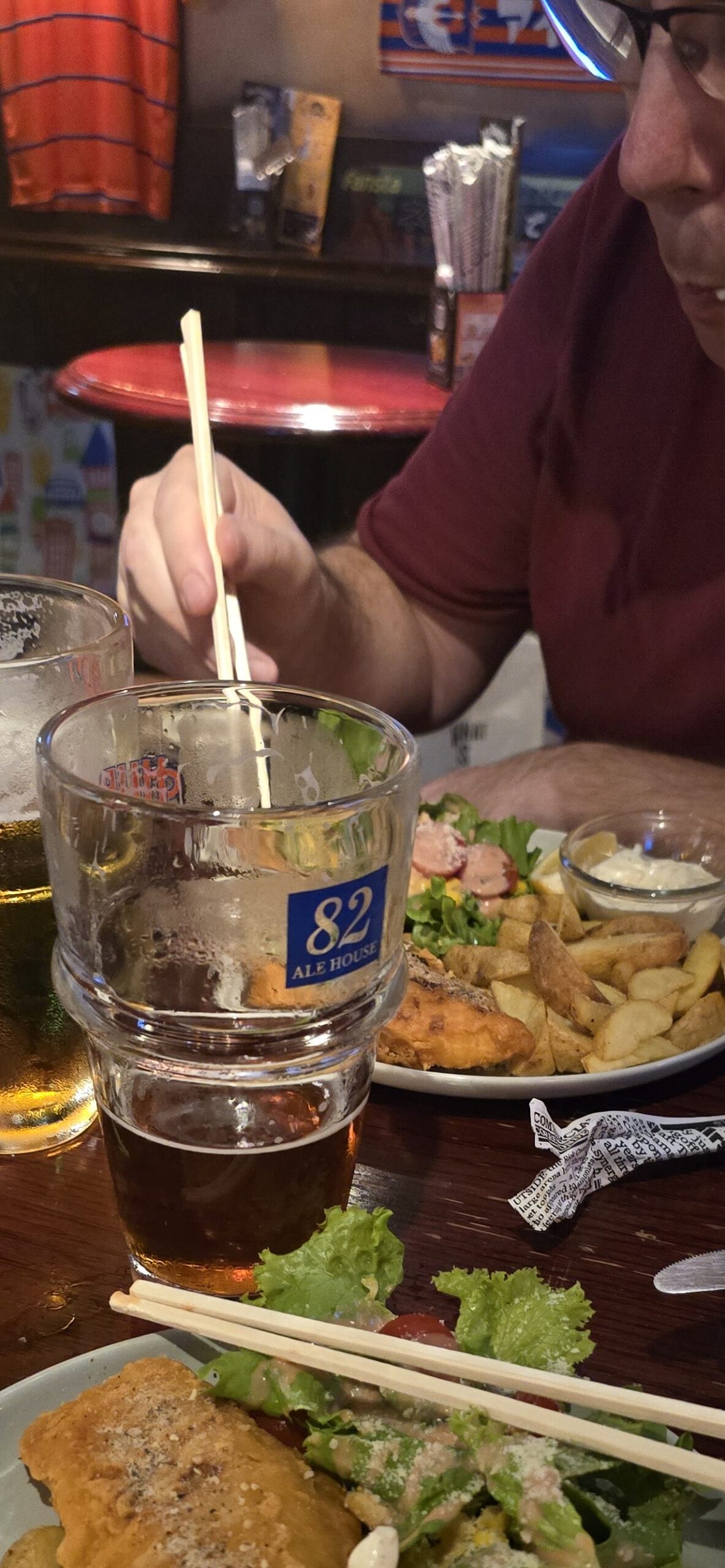
If you plan on visiting the HUB a number of times, get yourself a HUB card. Just ask at the bar and they will give you a card which gives you a discount every time you order.
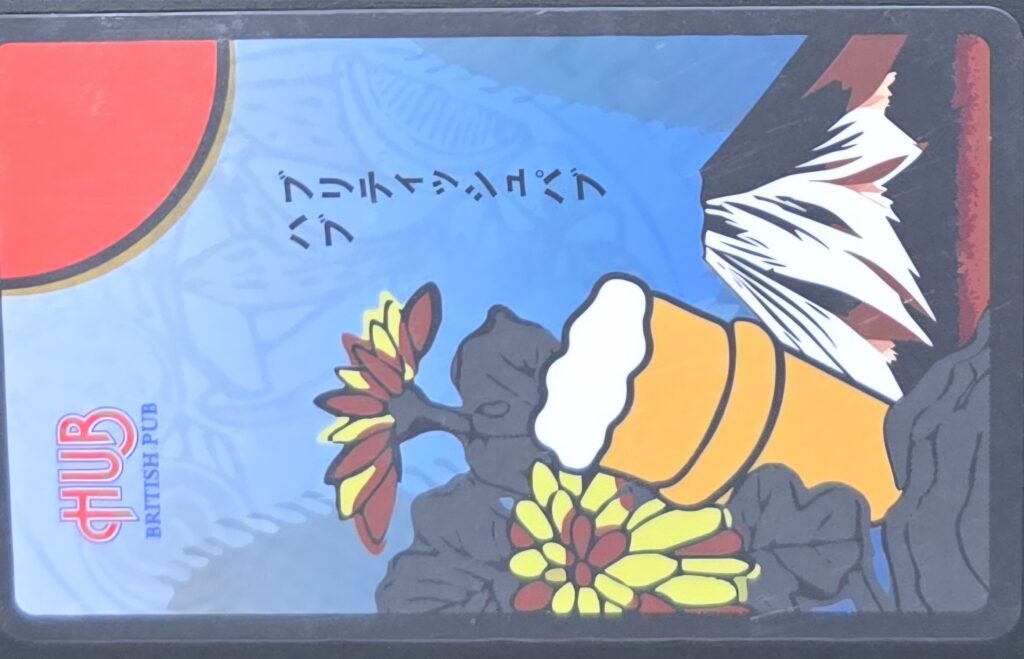
Godz Metal Bar:
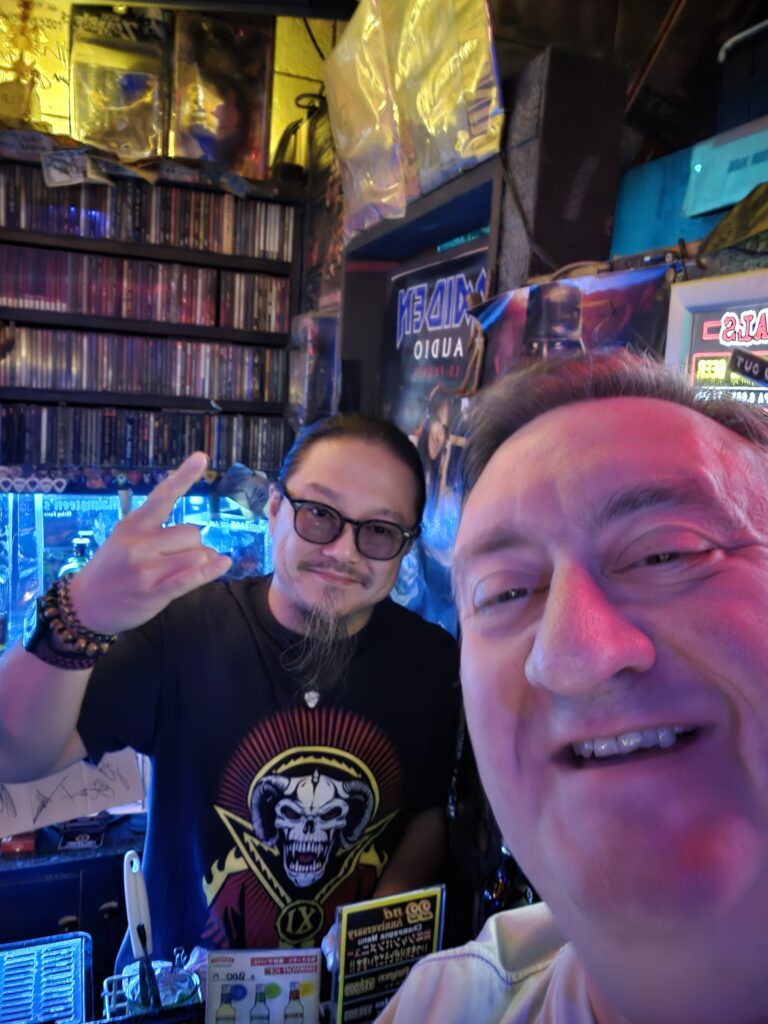
I am a heavy metal fan. Godz is a neon lit metal and heavy rock bar. They don’t play Japanese metal for some reason but will play your requests for everything else. Everyone is friendly and there are people from all over the world. I highly recommend a visit.
Rock Bar | GODZ -Official Website | 日本
Omoide Yokocho – Memory Alley:
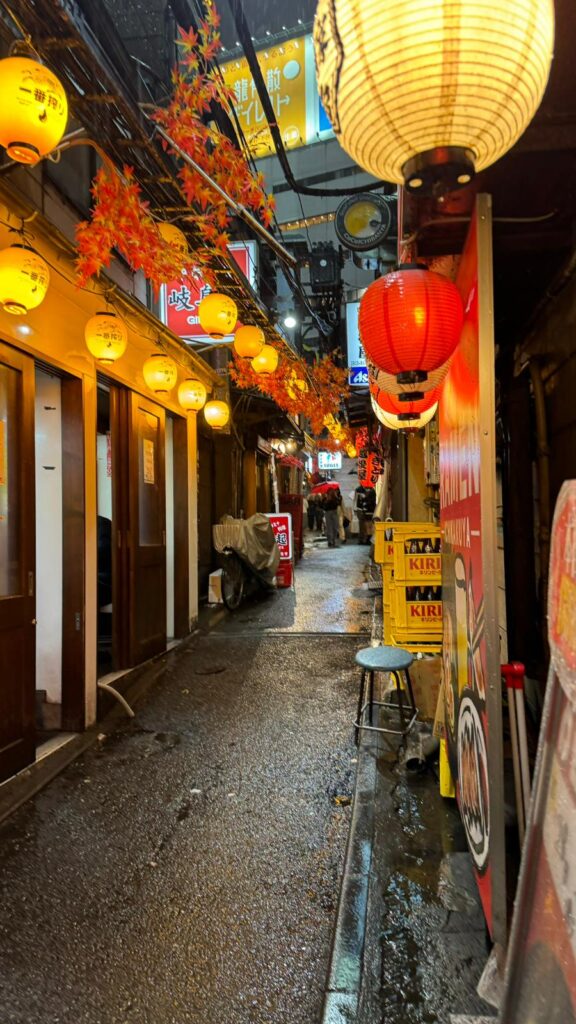
DO NOT TAKE PICTURES POINTING INSIDE THE ESTABLISHMENTS. I TOOK THE PICTURE OF THE SKEWERS BELOW AFTER ASKING FOR PERMISSION.
Memory Alley is actually two narrow streets next to Shinjuku train station.
All the establishments on the street are small, think 5 seats, ‘street’ food restaurants that are open to the street and sell all sorts of quick, freshly cooked food, such as skewers and squid.
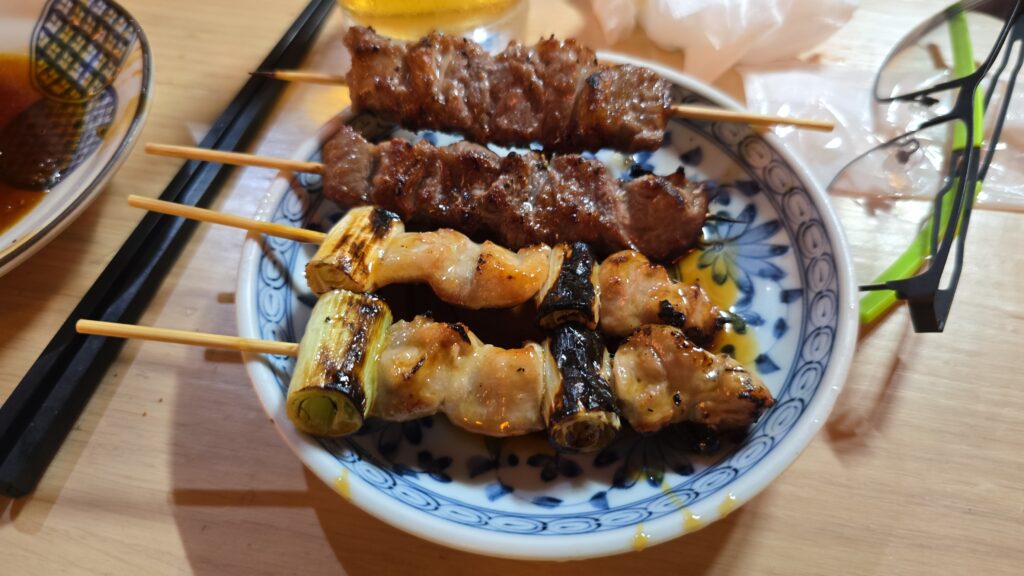
Highly recommended for a quick bite to eat in an environment that feels like old Japan (to a foreigner anyway!)
Official website of Shinjuku Nishiguchi Omoide Yokocho
Ryu no Su Restaurant (for Offal Soup):
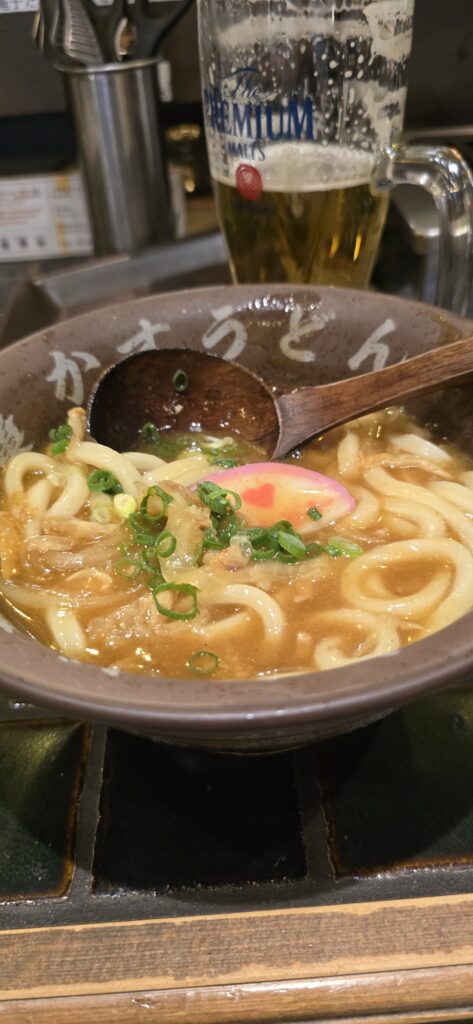
It sounds disgusting but it is a tasty katsu udon noodle soup that hits the spot at 2am in the morning! The restaurant is called Ryu no Su – Shinjuku Kabukicho
https://maps.app.goo.gl/x3H2jBMCU1YdswbL8
HEY arcade:
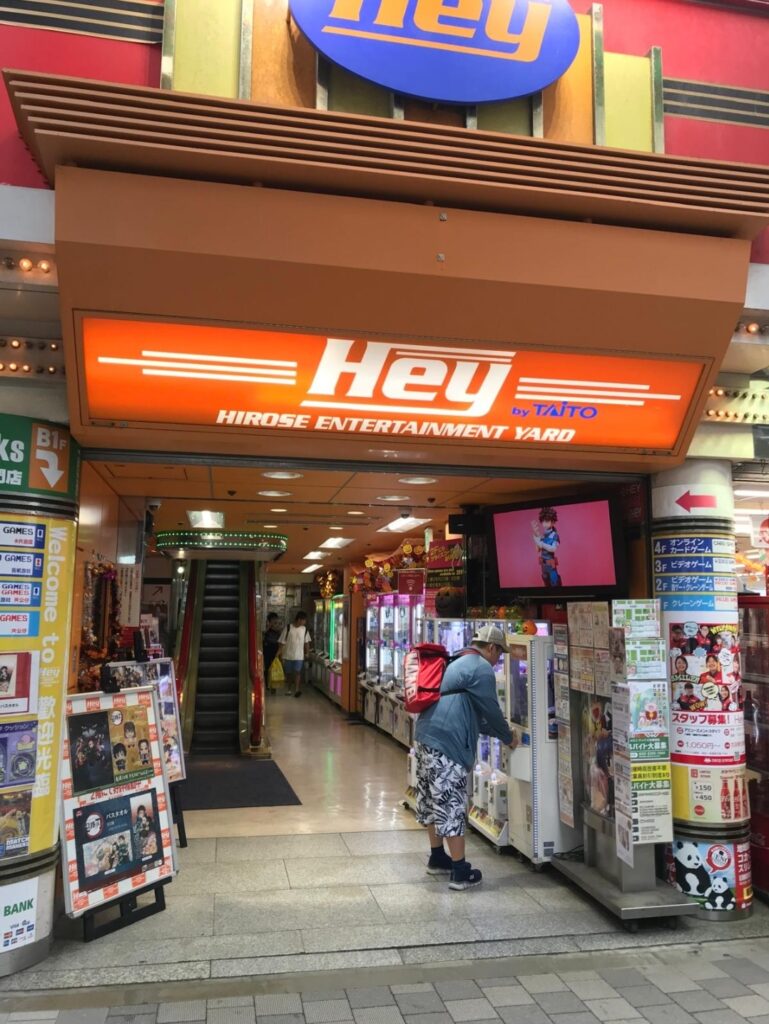
The arcades are the real reason I go to Japan but over the years the number and quality of them has reduced. Hirose Entertainment Yard (HEY) arcade is nestled between two great big GiGO arcades, close to Akihabara station. HEY has all manner of retro games but excels at shoot ’em ups, especially CAVE STGs (they have every CAVE game) and beat ’em ups.
Note that downstairs from HEY, in the basement, is a hentai manga and anime store so don’t go down there, unless that’s your kind of thing!
Mikado Arcade:
The only other decent arcade. Located in Takadanobab, it has a decent selection of retro games with larger dedicated cabs as well as candy cabs. Well worth a visit but not as good for CAVE games as HEY.
BEEP Games Store:
Located in Akihabara, BEEP is a new and second-hand retro games store. They sell games for every Japanese video game system you can think of with a small selection of hardware too. Like seemingly all Japanese stores, the shelves are tightly packed and only one Lee Ramsbottom sized belly can fit in a row at once. The staff are extremely friendly and helpful but don’t speak a lot of English. Translation apps are your friend.
Beep’s web site:
レトロPC・レトロゲーム、アーケード基板・筐体の販売買取|BEEP秋葉原
Super Potato Games Store:
Another, more famous, second-hand store in Akihabara. It is very similar to BEEP but is bigger and has a lot more hardware to choose from. I found the prices of the hardware to be comparable with that in the UK, maybe a little cheaper, but not cheap enough for me to risk putting whatever I buy in my suitcase.
Super Potato’s web site:
COCO Curry:
A chain of shops providing tasty and fast katsu curry. You walk in, are assigned a table, then just order, eat and are on your way out. They are extremely popular so you are likely to queue. You must visit at least once though!
Shinjuku Kabukicho store information | Store locator | Curry House CoCo Ichibanya
Ichiran Ramen: – also known as prison cell ramen!
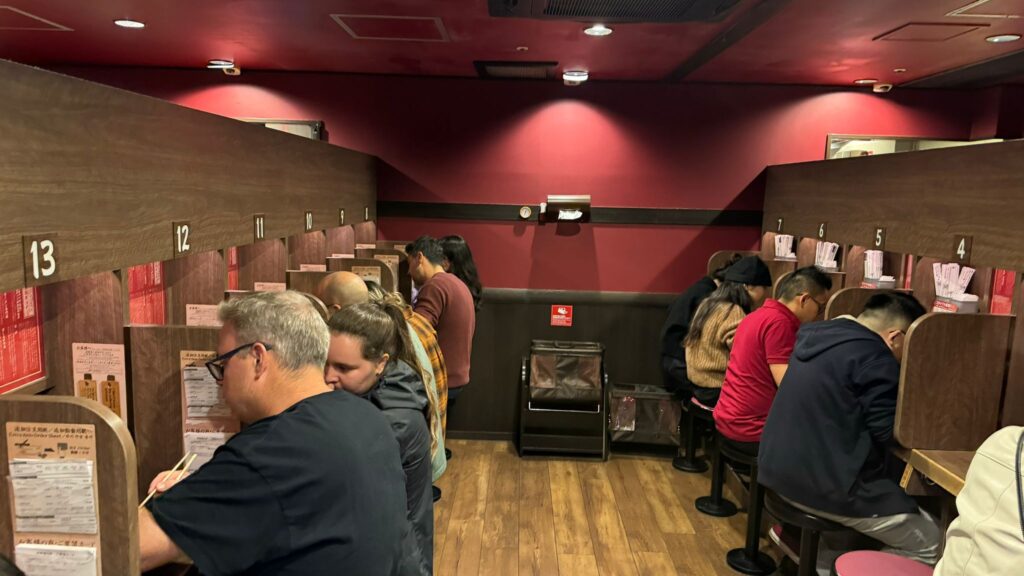
Located in Kabukicho, not only do they sell their unique and tasty ramen, but there is hardly any human interaction, perfect for introverts!
Enter the shop and a single waiter will show you to a machine to order your ramen, which gives you a ticket, and lead you to the waiting area. As soon as a cubicle is ready he will let you into the restaurant proper. There are 4 rows of individual seating areas with a divider on each side. In front of you is a small hatch (like a prison cell door hatch) which you put your ticket into. The waiter on the other side will take the ticket and close the hatch, and after a few minutes your food will be put through the hatch and the hatch closed.
Absolute minimum human interaction.
Note: this place is extremely popular, I had to wait a good 30 minutes in the queue!
Ichiran web site: 天然とんこつラーメン 一蘭
Doutor Coffee Shop:
Doutor is a coffee shop chain and almost identical to a UK coffee shop. I love to sit and people watch in them when I have a bit of time or need a bit of a chill-out.
I say almost identical because their sandwiches are freshly prepared, unlike in the UK where the major chains give you a manky cheese effort. Doutor’s sandwiches taste like real food and are prepared in front of you. My standard breakfast is a Doutor black coffee with a cheese (say cheezu) sandwich (option B on the English menu :-)). It also acts as a place to meet up with friends before heading out for the day.
https://maps.app.goo.gl/TnHu656CaQpoYifdA
Nonbei Yokocho – Drunkards Alley
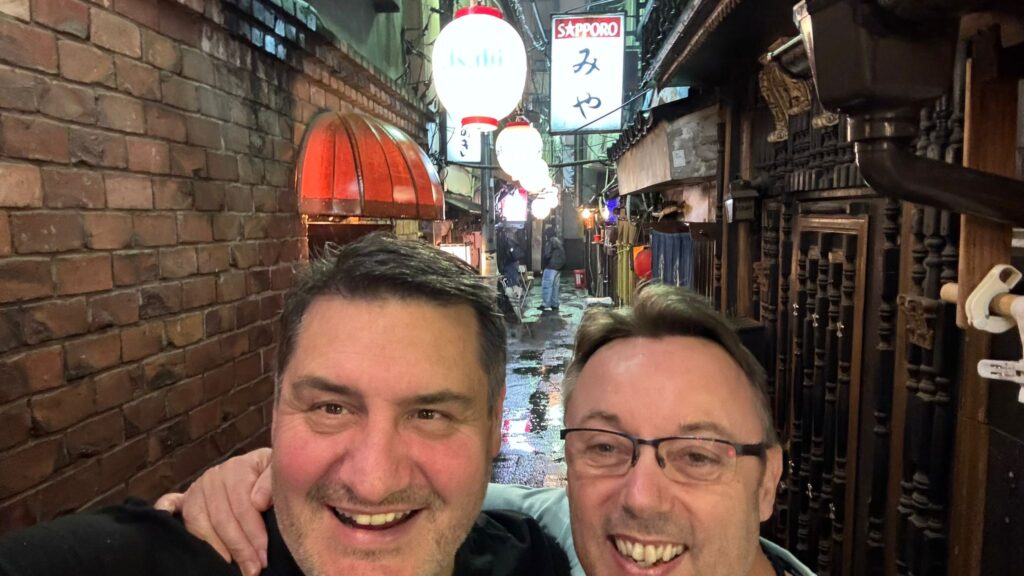
Over to Shibuya and there is one Golden Gai/Memory Alley style street known as Nonbei Yokocho – Drunkard’s Alley. You might miss it because it has a very narrow entrance behind a street that already looks like it might be the alley. It was closed until 4pm when I went so we had a few beers in a nearby restaurant until it opened.
https://maps.app.goo.gl/KoeH6Deq4YUoaT767
Tower Records:
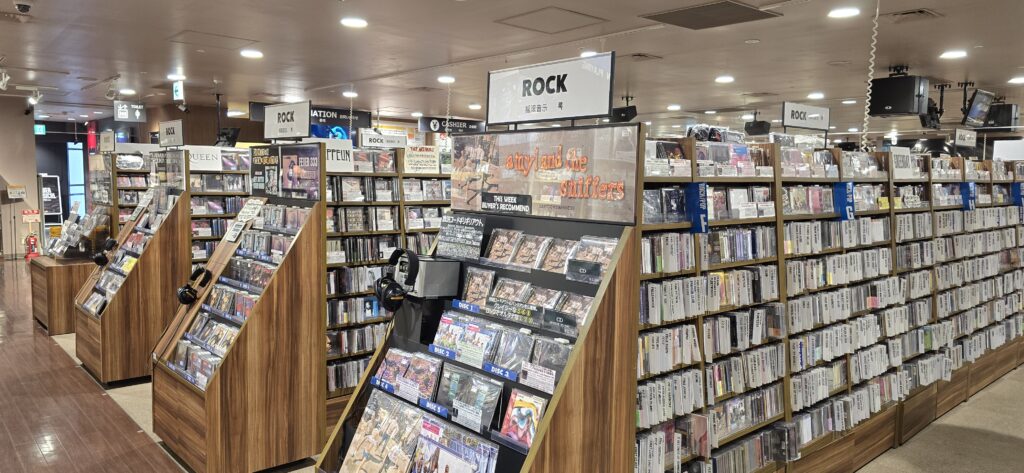
Tower Record is possibly Tokyo’s most famous record store. It does what it says on the tin, in that it is a huge tower full of music and video. Every taste is catered for.
If you are into idol bands then you are in luck because all the latest idol bands have their own display on the ground floor. All the other floors are packed with everything else you can imagine.
There is a tax-free counter on one of the upper floors (7 from memory). If you pay for your goods at a normal till, you can take your receipt to the tax free counter and get a refund of the VAT (you will need your passport as well, which you should have on you anyway). Honestly, I did it once then never again. I saved a couple of quid but the wait in the queue wasn’t worth it.
If you like your music then I reckon it’s worth a visit. It can be a struggle finding your band though because they are not organised by the British alphabet, they are organised by the Katakana alphabet. Good luck!
Senso-Ji Temple:
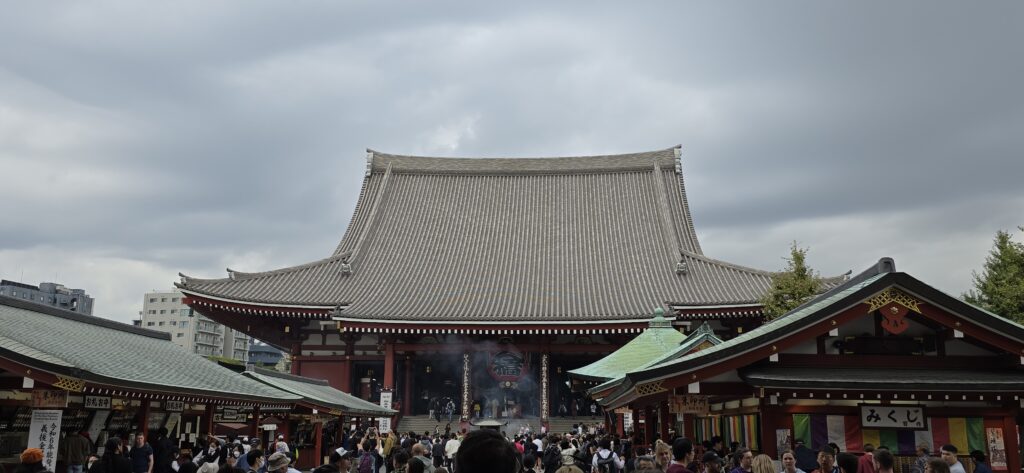
Senso-Ji Temple is the oldest temple in Tokyo. If you visit, please remember this is not tourist attraction. It is a Buddhist temple so treat it with the respect you would a church in the UK. It is deeply significant to many Japanese people, that includes the gates, buildings and very ground you walk on. Be respectful.
That said, the place is heaving with tourists! There is a large market in front of the temple that you could spend a day walking around if that’s your thing. A perfect place to buy some souvenirs.
https://maps.app.goo.gl/iwPnxMnCbg6mqkt86
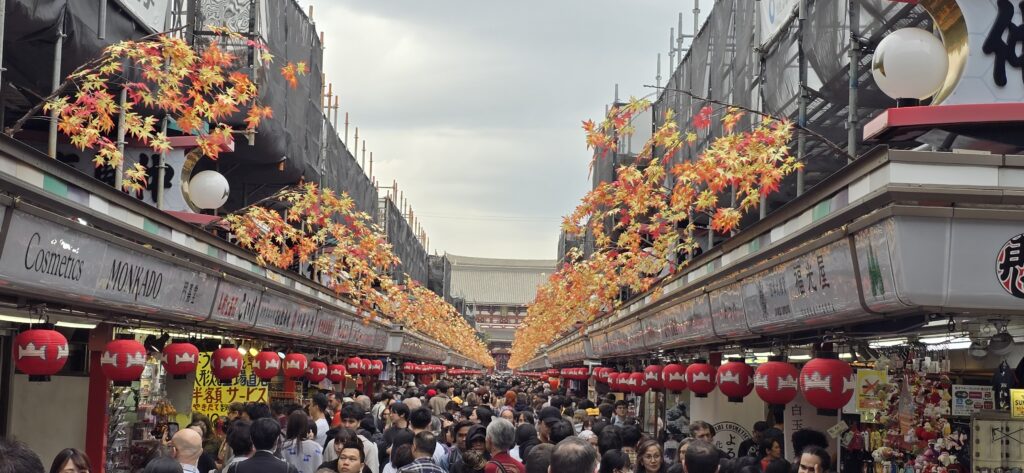
A Note About Temples and Shrines:
If you want to fire up your Legend of Zelda instincts and go to temples and shrines, Tokyo has lots of them, there’s even one in Shinjuku (Hanazono Shrine) just next to Golden Gai. You can be walking amongst the biggest, most modern buildings you have ever seen and nestled between them is an entrance to a temple or shrine. I have no interest in temples but search on google and you will find plenty of them.
There is a general etiquette, I believe, that if you visit a shrine and are not of the faith, then you enter from the side. I have only walked through the grounds and never been in one, but look this up and be respectful.
Also if you decide to clean your hands using one of the wooden ladles before entering the temple proper, make sure you take water from the pool with the ladle and then wash your hands outside of the pool, so the water drips onto the floor. Do not wash your hands over the pool water and drip back into it!
Hanazono Shrine – https://maps.app.goo.gl/iwPnxMnCbg6mqkt86
Tsukiji Nippon Fish Port Market:
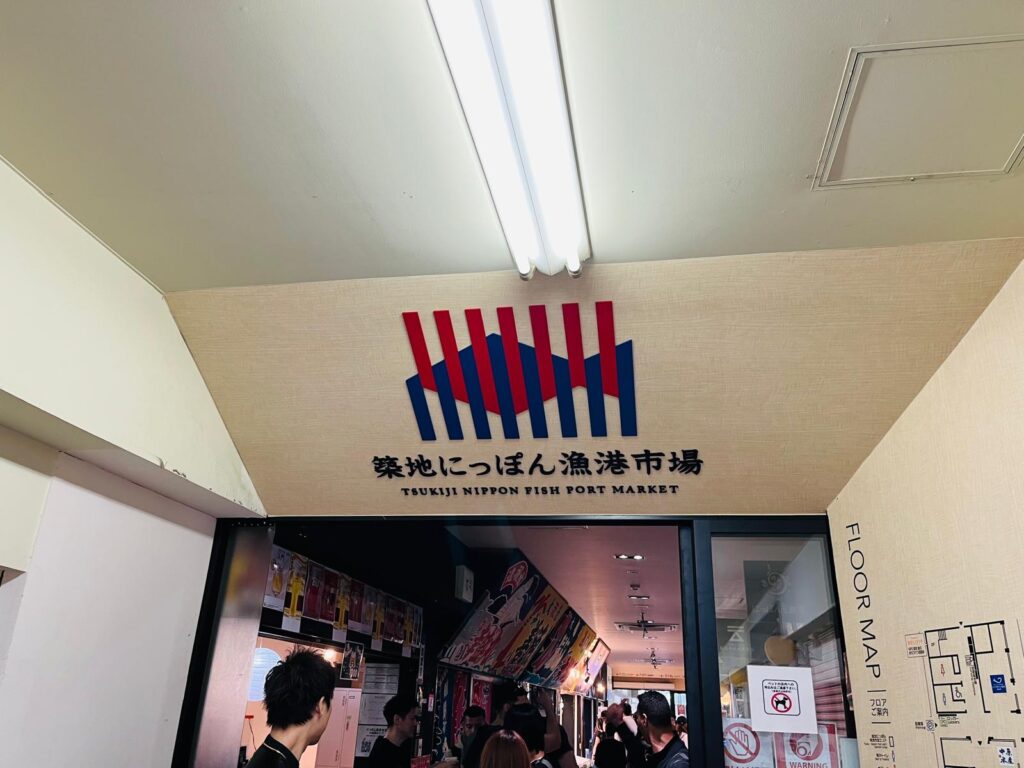
If markets are your thing (and they were my friend’s thing), check out Tsukiji Market.
Traditionally a fish market, it is now a large market selling all sorts of fish, as you would expect, but there are also lots of other food places where you can eat and have a beer. Probably good for a half-day visit
Get to know Tsukiji|Tsukiji Outer Market – Official Homepage
Google Maps location: https://maps.app.goo.gl/98hBkC1MEUvYYLzM8
Some Phrases to Learn:
Nippon or Nihon – Japan (the words can be used interchangeably)
Igiris – English (as in, from England in the UK)
Ohayo – Good morning (only used in the morning)
Konnichiwa – Hello (use this anytime)
Konbanwa – Good evening (only used in the evening, after dark)
Hai – yes
Arigato Gozaimas – Thank you very much (you will hear this constantly)
Sumimasen – Excuse me, or Sorry (you will also hear this constantly)
Ichi – One
Ni – Two
San – Three
Yon (or Shi) – Four
Go – Five
Concert Tickets.
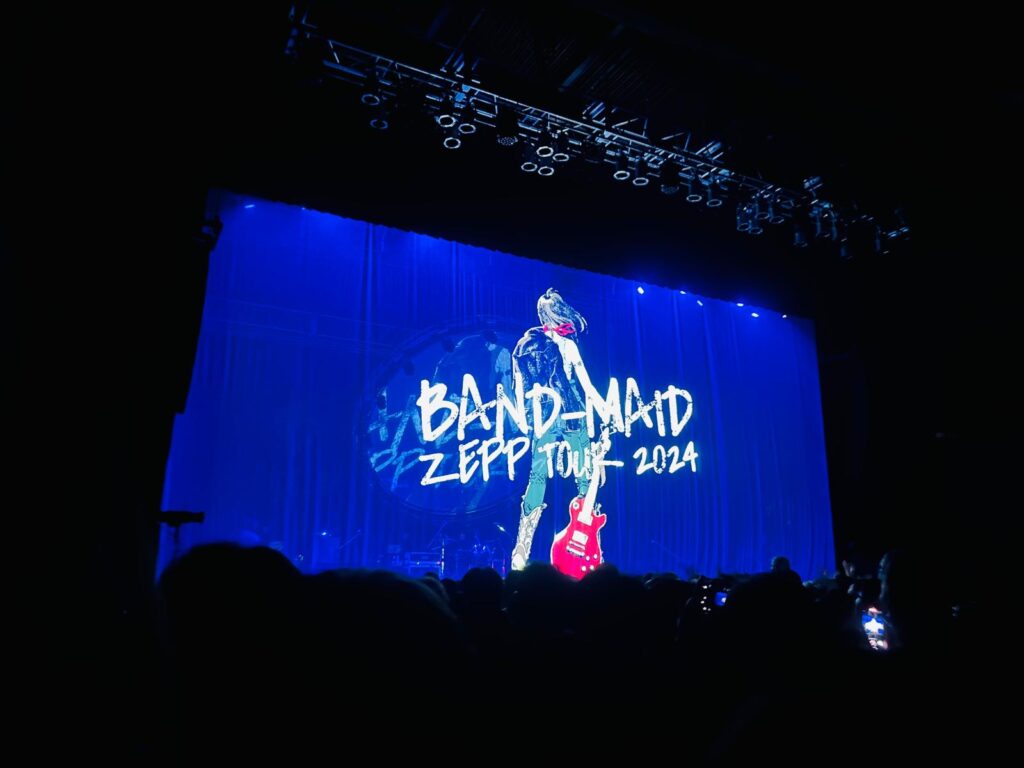
Buying tickets to watch your favourite band in Japan can be a bit of a nightmare. My friend has been to watch Band Maid twice and I have been once. I should mention that both venues were Zepp venues so I guess other venues could be different to what I describe below.
The Lottery: Unlike the UK, tickets are not released in a queuing system. You register your interest for the tickets, give your payment details, and then you are put into a lottery. There is no guarantee that you will get a ticket, or that anyone else in your party will get a ticket, except that sometimes you might (and I mean might) be able to register for multiple tickets.
If you are selected in the lottery your card will be charged and tickets sent to you either via email, a Lawson Ticket Machine or given to you at the venue itself.
If there is any kind of payment problem you will lose the ticket and you cannot appeal. That is why my friend has been to two concerts and me, one. My payment failed for some reason and that was it, I was out. I tried to appeal but just got a standard response saying, effectively, bugger off.
The International Lottery: Some concerts have a separate lottery for international customers and with Band-Maid it was advantageous, to be part of the fan club. Join the Japanese fan club of your band, assuming they are Japanese!
Tickets will be delivered as an e-ticket or a Lawson ticket machine reference number.
The Japanese Lottery: Not all concerts will provide tickets for international customers. The ticket sales for Japanese customers is the same deal, it’s a lottery.
I have tried many guides online that try to take you through pretending you are Japanese using a combination of a VPN and your hotel address and telephone number. They used to work but not any more. Every which way you try you always end up needing a Japanese mobile number so you can get a confirmation text. I tried the free Japanese mobile numbers online that allow you to receive a text and none of them worked.
The only reliable way I have found to get tickets in the Japanese lottery is to find a proxy to do it for you for a commission. This means asking a Japanese person to enter the lottery and send you the tickets if you win the lottery. This is how we bought our second set of tickets and got to watch Band Maid at Zepp Nagoya.
It is worth noting we have had no problems gaining entrance to the events even though we are foreigners with Japanese tickets.
We used a proxy – Junichi Tanaka at Ticket Japaan. He used my friends name in the lottery with a Japanese phone number and provided everything we needed to print tickets at a Lawson ticket machine. It was a smooth way for us to get tickets and I highly recommend him (again this is not sponsored).
Ticket Japaaan | Get tickets to Japanese shows
Lawson Ticket Machines: When you receive a ticket (assuming it’s not an e-ticket with QR code) you will likely get a reference number of some kind that you need to take to a Lawson ticket machine (iTike). Remember the Lawson conbinis I mentioned earlier? Every one of them has one or more Lawson ticket machines. No matter where you go you are within 3 minutes of a Lawson ticket machine. Just go to the machine, switch it to English and follow the options for printing tickets. Bob is your uncle, Fanny is your aunt and Dick is your best mate.
At the venue: Again everything is different! Entrance is based on priority depending on which tickets you have. You will enter as instructed by the staff managing the queue outside the venue. If you show up a little later than expected and your cohort has gone in already, you do not need to queue – just walk straight to the front and you will be let in! The staff in the queue understand a little English, enough to show them your ticket and for them tell you where to go.
The Zepp token: At both venues I went to it was mandatory to buy a Zepp token on entry. At the time of writing it was 800 yen and you paid with a Suica Welcome card, not cash. I repeat, mandatory, they will not let you in if you don’t buy one.
Once inside you can redeem the token for a beer or other drink. Top Tip: The vast majority of people head to the bar to cash in the token for said beer, leaving you with the chance to walk straight into a practically empty room and get right to the front (and use the token as a souvenir!). My mate was at the barrier in front of the stage, in the centre, after doing this. If you get close to the stage be prepared to fend off umpteen Japanese people trying to get in front of you. Stay steadfast, brave Japanese concert goer!
And Finally – A Picture of Godzilla, Because Why Not?
